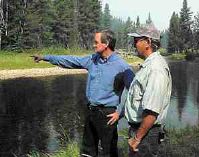forum
library
tutorial
contact

Crapo Checks on Salmon After Fires
by Gregory HahnIdaho Statesman - August 23, 2000
|
the film forum library tutorial contact |

|
Crapo Checks on Salmon After Firesby Gregory HahnIdaho Statesman - August 23, 2000 |
 BURGDORF JUNCTION -- The water
in the Secesh River roils and churns
in spots where the skies above it
crackled and burned just weeks ago.
BURGDORF JUNCTION -- The water
in the Secesh River roils and churns
in spots where the skies above it
crackled and burned just weeks ago.
Not far from where the now 50,000-acre Burgdorf fire started north of McCall, the state's last surviving major run of wild summer chinook salmon are spawning in the river their ancestors swam.
About 550 fish -- all but 10 wild -- made their way back to the Secesh River this year, and Idaho Fish and Game's Regional Fisheries Manager Don Anderson estimates they could leave as many as 250 redds, or spawning beds.
The last time the summer chinook left more than 200 redds here was 1962. Last summer, between 80 and 100 fish created 37 redds.
The Secesh run is unique because it's the only population not extensively diluted by hatchery fish. This year, Anderson said, more than 6,000 hatchery fish passed the mouth of the Secesh on their way up the South Fork of the Salmon River.
Several of the fish put on a spectacular show Tuesday morning for Idaho Sen. Mike Crapo, who came to gauge what damage, if any, the fires have caused salmon habitat, and to gather background information for new salmon hearings he's called in Washington, D.C.
The senator and a few others watched, enraptured, as a stalwart female readied herself and her stretch of the gravel bar while several males -- up to three and four feet long -- battled for position around her.
"That's actual redd construction; the male is positioning himself ... you're about to see the whole process," Anderson said.
The smallest, a 3-year-old fish that had just spent the past year at sea, was no match for his older and much larger competition. But Anderson said if the young fish timed his run just right, he could fertilize some of the female's 5,000 eggs.
"You've got a 5-year-old male, a 4-year-old male and a 3-year-old male, all fertilizing at least some of the 4-year-old female's eggs," he said.
Crapo, who had never seen wild ocean-going salmon spawn, was impressed with the Herculean efforts the fish made just to get there.
They travel more than 500 miles and climb about a mile in elevation. Each female will spend a week at her redd, after finding the perfect spot on the stream bed and the perfect flow of water around it. She'll move about a cubic yard of gravel before she's done.
"I figured they just came up, spread the gravel around a little bit and laid their eggs," Crapo said.
When the salmon fry hatch, they can be under as much as 18 inches of gravel, and Anderson said that's the point at which nearby fires could affect the fish.
Without the forest cover, more sediment will wash to the river, and that could clog the redds, cutting off oxygen to the fish and, in bad cases, block the passageways out of their gravel beds.
But Anderson said he didn't expect much damage from the Burgdorf fire -- he pointed out where the flames crossed over the river, and it was hard to tell the fire had even been there. A healthy riparian area around the river will be greener and cooler, Anderson said, and that's built-in fire protection.
The piney area surrounding the spawning chinook was marred only by an occasional hoof-print, perhaps left by the mature bull moose that appeared and stared impassively as the senator and the others walked past.
Crapo and his staff said Idaho has more than enough healthy spawning grounds. He said he's concerned the federal salmon plan may rely too much on changes here, and not enough on the obstacles salmon encounter in the main rivers and in the ocean. His Public Works Subcommittee will have two hearings in September to talk about the best ways to help the fish over the next five to eight years -- the time limit set before the federal government will again consider breaching the lower Snake River dams.
These decisions are vital, Crapo said.
"I wish everybody in the entire Pacific Northwest could see what we're seeing here today," he said.
In the shallow Secesh River, Anderson's trained eyes can pick new and old redds out of the variously sized rocks along the bottom, and before Crapo and the rest left, two other females were thrashing above their chosen sites and two of the largest, most battle-scarred males staged a violent skirmish that carried the dueling suitors across the rocky stretch of rapids.
"I don't think you could have picked a better day," Anderson said. "This is intense spawning."
learn more on topics covered in the film
see the video
read the script
learn the songs
discussion forum
